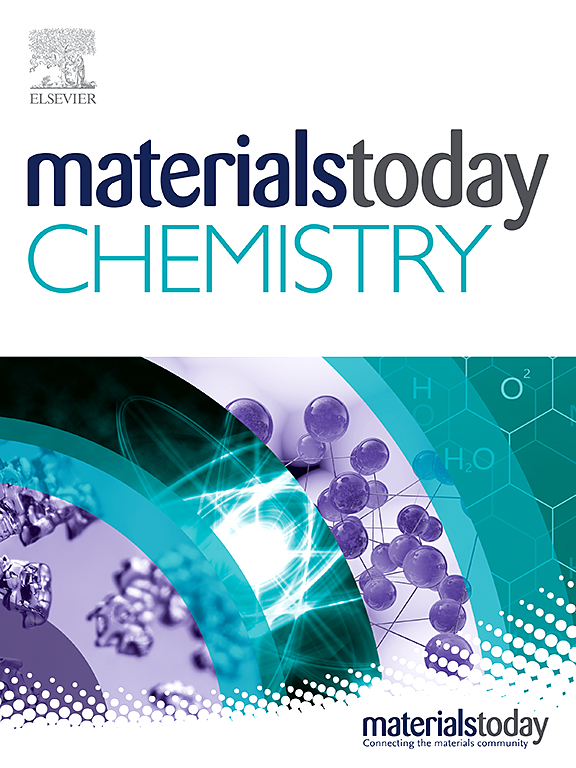用于染料吸附和光催化降解的三维打印 MOF/MoS2 气凝胶
IF 6.7
2区 化学
Q1 CHEMISTRY, MULTIDISCIPLINARY
引用次数: 0
摘要
有毒污染物对水资源污染的挑战不断升级,亟需政府和社会的关注。此外,传统水处理方法的低效强调了探索开发可负担、可再生和高性能材料的极端必要性,例如,这些材料应能实现有机污染物的相互吸附和光催化降解。在此,我们采用三维打印技术制造了一种气凝胶,它以海藻酸盐、明胶和羧甲基纤维素为基础,掺入了 5 和 7.5 wt % 的 MOF/MoS。傅立叶变换红外光谱和 EDS 分析表明气凝胶结构中含有 MOF/MoS,而氦气压计分析和扫描电镜显微照片则表明气凝胶密度低,结构多孔,孔隙率超过 80%。膨胀测试表明,气凝胶在浸泡 70 小时后具有很高的吸水能力(1400%)。流变学测试表明,弹性行为优于粘性行为(G' > G″),加入 7.5 wt % 的 MOF/MoS 有利于水凝胶的剪切稀化和粘度恢复。对亚甲基蓝(用作模型)的吸附测试表明,不含 MOF/MoS 的气凝胶(HD)、HD/MOF/MoS 5 % 和 MOF/MoS 7.5 % 的气凝胶的去除率分别为 16.77 %、28.66 % 和 95.86 %。相反,光降解测试表明,HD/MOF/MoS 5 % 和 HD/MOF/MoS 7.5 % 的效率分别为 89 % 和 80 %。因此,我们的研究结果表明,所开发的气凝胶具有吸附和光降解染料的潜力,而且成本低、环保、易于制造。本文章由计算机程序翻译,如有差异,请以英文原文为准。
3D-printed MOF/MoS2 aerogel for dye adsorption and photocatalytic degradation
The escalating challenge of water resources contamination, attributed to toxic pollutants, requires urgent attention from both governments and society. Furthermore, the inefficacy of conventional water treatment methods emphasizes the critical necessity for exploring the development of affordable, renewable, and high-performance materials, which should, for instance, enable the mutual adsorption and photocatalytic degradation of organic pollutants. Here we employed the 3D printing technique to manufacture an aerogel based on alginate, gelatin, and carboxymethylcellulose incorporated with 5 and 7.5 wt % of MOF/MoS. FTIR spectra and EDS analysis evidenced the presence of MOF/MoS in the structure of the aerogels, while Helium pycnometer analysis and SEM micrographs demonstrated that the aerogels presented low density and a porous structure with porosity above 80 %. The swelling test showed that the aerogels displayed a high water absorption capacity (1400 %) after 70 h of immersion. The rheology test demonstrated that elastic behavior prevails over viscous behavior (G' > G″) and the incorporation of 7.5 wt % MOF/MoS favored shear thinning and viscosity recovery in the hydrogel. Adsorption tests to methylene blue (employed as a model) showed that the aerogel (HD) without the presence of MOF/MoS and the aerogels HD/MOF/MoS 5 % and MOF/MoS 7.5 % showed removal efficiencies of 16.77 %, 28.66 %, and 95.86 %, respectively. Conversely, the photodegradation test showed that HD/MOF/MoS 5 % and HD/MOF/MoS 7.5 % had an efficiency of 89 % and HD of 80 %. Therefore, our results demonstrate that the developed aerogels are promising candidates for the adsorption and photodegradation of dye while being low-cost, environmentally friendly, and easy to manufacture.
求助全文
通过发布文献求助,成功后即可免费获取论文全文。
去求助
来源期刊

Materials Today Chemistry
Multiple-
CiteScore
8.90
自引率
6.80%
发文量
596
审稿时长
33 days
期刊介绍:
Materials Today Chemistry is a multi-disciplinary journal dedicated to all facets of materials chemistry.
This field represents one of the fastest-growing areas of science, involving the application of chemistry-based techniques to the study of materials. It encompasses materials synthesis and behavior, as well as the intricate relationships between material structure and properties at the atomic and molecular scale. Materials Today Chemistry serves as a high-impact platform for discussing research that propels the field forward through groundbreaking discoveries and innovative techniques.
 求助内容:
求助内容: 应助结果提醒方式:
应助结果提醒方式:


